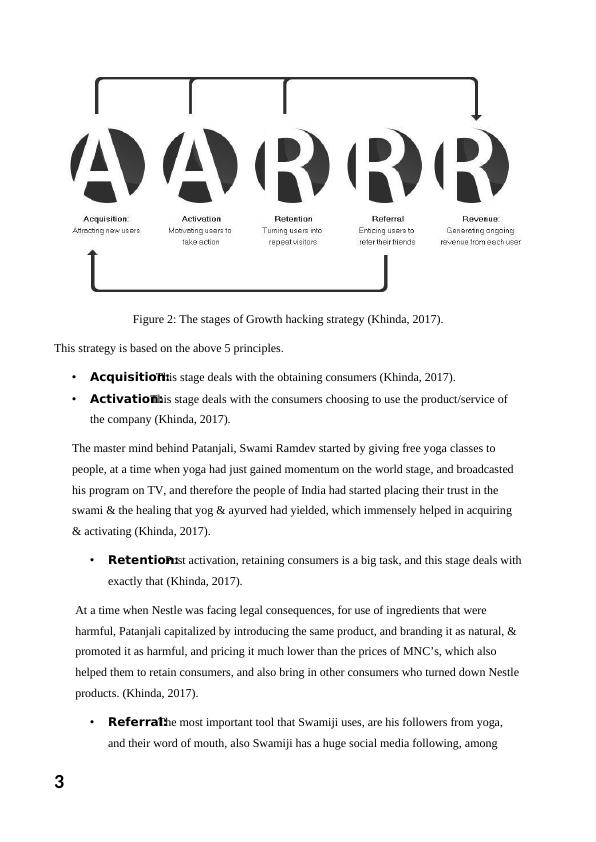TASK - I Strategic Direction Growth Hacking Strategy Patanjali
Added on 2021-08-06
22 Pages5200 Words270 Views
STRATEGIC MANAGEMENT -
PATANJALI

1
Sl. No. Page No.
TASK - I
2
2
TASK - II
5
7
TASK - III
10
10
10
TASK - IV
14
15
TASK - V
18
6 References 20
2
3
Table of Contents
Title
1 Strategic Direction
Growth Hacking Strategy
Market Development Strategy4
5
Focused Differentiation Strategy
Final Conclusion
PESTLE Analysis
Porter's 5 Forces
Vision & Mission
Strategic Drift
Business Model Canvas
Sl. No. Page No.
TASK - I
2
2
TASK - II
5
7
TASK - III
10
10
10
TASK - IV
14
15
TASK - V
18
6 References 20
2
3
Table of Contents
Title
1 Strategic Direction
Growth Hacking Strategy
Market Development Strategy4
5
Focused Differentiation Strategy
Final Conclusion
PESTLE Analysis
Porter's 5 Forces
Vision & Mission
Strategic Drift
Business Model Canvas

2
TASK – 1
Founded in 2006, Patanjali Ayurved Limited (hereafter referred to as Patanjali) has grown
spectacularly with an annual turnover touching nearly €1.16 bn, in the fiscal year 2016-17, the
success is attributed to combined factors like low costs, being a local brand thereby appealing to
people on a grass root level & having an exceptional distribution system, eventually disrupting
the Indian FMCG market (Gupta, et al., 2016).
The vision of Patanjali has always been focus on Nationalism, Ayurved & Yog as pillars, while
promoting a society that is healthier, by introducing the benefits of nature, while the mission is to
advance Ayurveda (Patanjali, 2020).
The strategy followed by Patanjali is “Growth Hacking Strategy”, this strategy is based on
experiments, and combinations to see what works best for the organization, and the prime goal of
this strategy, is to obtain multitude consumers, without spending a lot, therefore it is a
combination of cost effective strategies (Optinmonster, 2020).
Figure 1: Growth Hacking Strategy (Gasteren, 2020).
The strategy is a “combination of marketing, data & technology” (Gasteren, 2020).
The strategy is taken forward by the “Growth Hacker”, for Patanjali, the growth hacker is
“Swami Ramdev” himself, who is the founder & biggest brand ambassador himself (Khinda,
2017).
TASK – 1
Founded in 2006, Patanjali Ayurved Limited (hereafter referred to as Patanjali) has grown
spectacularly with an annual turnover touching nearly €1.16 bn, in the fiscal year 2016-17, the
success is attributed to combined factors like low costs, being a local brand thereby appealing to
people on a grass root level & having an exceptional distribution system, eventually disrupting
the Indian FMCG market (Gupta, et al., 2016).
The vision of Patanjali has always been focus on Nationalism, Ayurved & Yog as pillars, while
promoting a society that is healthier, by introducing the benefits of nature, while the mission is to
advance Ayurveda (Patanjali, 2020).
The strategy followed by Patanjali is “Growth Hacking Strategy”, this strategy is based on
experiments, and combinations to see what works best for the organization, and the prime goal of
this strategy, is to obtain multitude consumers, without spending a lot, therefore it is a
combination of cost effective strategies (Optinmonster, 2020).
Figure 1: Growth Hacking Strategy (Gasteren, 2020).
The strategy is a “combination of marketing, data & technology” (Gasteren, 2020).
The strategy is taken forward by the “Growth Hacker”, for Patanjali, the growth hacker is
“Swami Ramdev” himself, who is the founder & biggest brand ambassador himself (Khinda,
2017).

3
Figure 2: The stages of Growth hacking strategy (Khinda, 2017).
This strategy is based on the above 5 principles.
• Acquisition: This stage deals with the obtaining consumers (Khinda, 2017).
• Activation: This stage deals with the consumers choosing to use the product/service of
the company (Khinda, 2017).
The master mind behind Patanjali, Swami Ramdev started by giving free yoga classes to
people, at a time when yoga had just gained momentum on the world stage, and broadcasted
his program on TV, and therefore the people of India had started placing their trust in the
swami & the healing that yog & ayurved had yielded, which immensely helped in acquiring
& activating (Khinda, 2017).
• Retention: Post activation, retaining consumers is a big task, and this stage deals with
exactly that (Khinda, 2017).
At a time when Nestle was facing legal consequences, for use of ingredients that were
harmful, Patanjali capitalized by introducing the same product, and branding it as natural, &
promoted it as harmful, and pricing it much lower than the prices of MNC’s, which also
helped them to retain consumers, and also bring in other consumers who turned down Nestle
products. (Khinda, 2017).
• Referral: The most important tool that Swamiji uses, are his followers from yoga,
and their word of mouth, also Swamiji has a huge social media following, among
Figure 2: The stages of Growth hacking strategy (Khinda, 2017).
This strategy is based on the above 5 principles.
• Acquisition: This stage deals with the obtaining consumers (Khinda, 2017).
• Activation: This stage deals with the consumers choosing to use the product/service of
the company (Khinda, 2017).
The master mind behind Patanjali, Swami Ramdev started by giving free yoga classes to
people, at a time when yoga had just gained momentum on the world stage, and broadcasted
his program on TV, and therefore the people of India had started placing their trust in the
swami & the healing that yog & ayurved had yielded, which immensely helped in acquiring
& activating (Khinda, 2017).
• Retention: Post activation, retaining consumers is a big task, and this stage deals with
exactly that (Khinda, 2017).
At a time when Nestle was facing legal consequences, for use of ingredients that were
harmful, Patanjali capitalized by introducing the same product, and branding it as natural, &
promoted it as harmful, and pricing it much lower than the prices of MNC’s, which also
helped them to retain consumers, and also bring in other consumers who turned down Nestle
products. (Khinda, 2017).
• Referral: The most important tool that Swamiji uses, are his followers from yoga,
and their word of mouth, also Swamiji has a huge social media following, among

4
general public as well as movie stars & politicians, that helps him promote his brand
(Khinda, 2017).
• Revenue: The revenue for patanjali is generated, through sale of its products, and that
is made possible through the websites run by them, and also physical stores that are
present in both rural as well as urban India (Khinda, 2017).
The above explanation simply shows how Patanjali has used this strategy to outperform some big
companies in the Indian FMCG sector.
general public as well as movie stars & politicians, that helps him promote his brand
(Khinda, 2017).
• Revenue: The revenue for patanjali is generated, through sale of its products, and that
is made possible through the websites run by them, and also physical stores that are
present in both rural as well as urban India (Khinda, 2017).
The above explanation simply shows how Patanjali has used this strategy to outperform some big
companies in the Indian FMCG sector.

5
TASK - 2
§ PESTLE Analysis of Patanjali.
Figure 3: Components of Pestle Analysis (Thiele, 2018).
➢ Political: With the introduction of AYUSH in 2014, which is a ministry of the
government of India to promote alternative medicines, everything changed, along with
the political relations of Swamiji himself to support his venture, which gives him a boost,
and thirdly the concept of “Make in India”, introduced by the government, to promote
local businesses & industries, gave Patanjali the push it needed to pursue its business
plans (MBA Skool, 2019).
▪ The support from political parties to the yoga guru is not new to any Indian, there
are countless articles, and also events, where the same can be seen, there is
immense support for Swamiji, and so does the support for the brand Patanjali.
Figure 3: The Prime Minister of India with Swamiji (Hindustan Times, 2017).
TASK - 2
§ PESTLE Analysis of Patanjali.
Figure 3: Components of Pestle Analysis (Thiele, 2018).
➢ Political: With the introduction of AYUSH in 2014, which is a ministry of the
government of India to promote alternative medicines, everything changed, along with
the political relations of Swamiji himself to support his venture, which gives him a boost,
and thirdly the concept of “Make in India”, introduced by the government, to promote
local businesses & industries, gave Patanjali the push it needed to pursue its business
plans (MBA Skool, 2019).
▪ The support from political parties to the yoga guru is not new to any Indian, there
are countless articles, and also events, where the same can be seen, there is
immense support for Swamiji, and so does the support for the brand Patanjali.
Figure 3: The Prime Minister of India with Swamiji (Hindustan Times, 2017).

End of preview
Want to access all the pages? Upload your documents or become a member.
